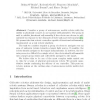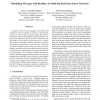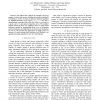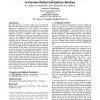HOLOMAS
2005
Springer
13 years 10 months ago
2005
Springer
Within this paper we describe a simulation environment for the underwater surveillance and propose architecture of control part of autonomous robot capable of efficient operation i...
ECAL
2005
Springer
13 years 10 months ago
2005
Springer
Consider a group of autonomous, mobile robots with the ability to physically connect to one another (self-assemble). The group is said to exhibit functional self-assembly if the ro...
ATAL
2005
Springer
13 years 10 months ago
2005
Springer
This paper introduces a multi-robot cooperation approach to solve the pursuit evasion problem for mobile robots that have omnidirectional vision sensors in unknown environments. T...
RTAS
2005
IEEE
13 years 10 months ago
2005
IEEE
Consider a team of robots equipped with sensors that collaborate with one another to achieve a common goal. Sensors on robots produce periodic updates that must be transmitted to ...
ICRA
2005
IEEE
13 years 10 months ago
2005
IEEE
Building cooperatively 3-D maps of unknown environments is one of the application fields of multi-robot systems. This article addressesthatproblemthroughaprobabilisticapproachbas...
ICRA
2005
IEEE
13 years 10 months ago
2005
IEEE
Abstract— We are developing a swarm-intelligent inspection system based on a swarm of autonomous, miniature robots, using only on-board, local sensors. To estimate intrinsic adva...
ICRA
2005
IEEE
13 years 10 months ago
2005
IEEE
— We address the synthesis of controllers for large groups of robots and sensors, tackling the specific problem of controlling a swarm of robots to generate patterns specified ...
AINA
2005
IEEE
13 years 10 months ago
2005
IEEE
In this paper, we consider a distributed system that consists of a group of teams of worker robots that rely on physical robot messengers for the communication between the teams. ...
HRI
2006
ACM
13 years 10 months ago
2006
ACM
This paper presents the combined results of two studies that investigated how a robot should best approach and place itself relative to a seated human subject. Two live Human Robo...
HRI
2006
ACM
13 years 10 months ago
2006
ACM
This paper describes an extensive analysis of the comfort level data of 7 subjects with respect to 12 robot behaviours as part of a human-robot interaction trial. This includes ro...




